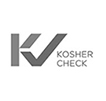Ground Coffee vs. Whole Bean Coffee
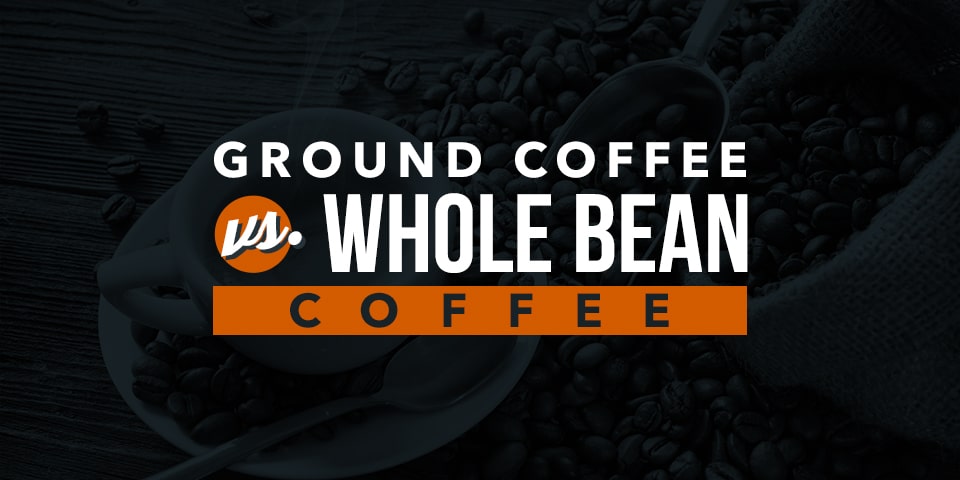
If you’re thinking about selling coffee or expanding your existing coffee brand, you need to know the difference between whole bean and ground coffee. Understanding what sets these coffee products apart from each other will help you cater to your target audience better and make more sales.
Below, you’ll learn the details of ground vs. whole bean coffee, including what benefits each brings to the table and the drawbacks to be aware of. After going over the pros and cons of your options and what type appeals more to various customers, you’ll be able to decide which item is best for your brand to offer.
What Is Whole Bean Coffee?
Whole bean coffee is just like it sounds — roasted coffee beans in full. Because customers can’t make coffee with whole beans, they need a grinder to brew a fresh pot of coffee. Whole bean coffee can come in various styles and flavors, depending on the roasting technique.
Many customers prefer purchasing whole bean coffee because it grants them the freedom to grind the beans to their favorite specifications. Selling whole bean coffee allows customers to adjust the size of their coffee grounds to match their favorite brewing method. As a bonus, whole bean coffee also packs more flavor per cup since you aren’t exposing the tasty compounds to oxygen until you’re ready to brew.
What Is Ground Coffee?
Ground coffee is a popular choice among avid coffee consumers because of the convenience it offers. Purchasing ground coffee eliminates the time, energy and extra equipment it takes for consumers to grind the beans themselves. Ground coffee drinkers only need to scoop the coffee into a coffee machine and hit the brew button.
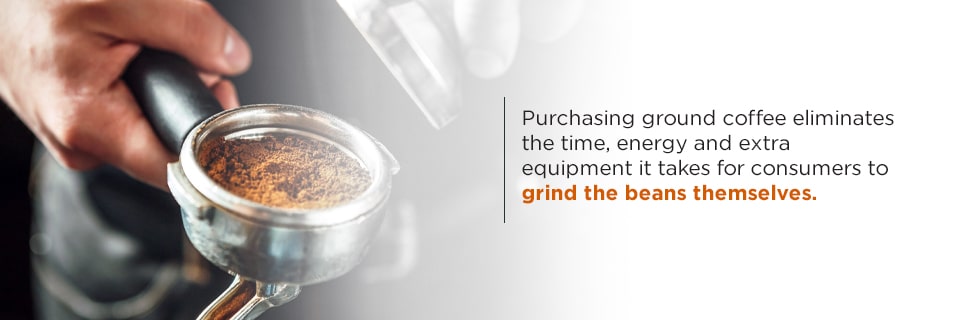
A bag of ground coffee provides the dependability of a consistent brew that customers can count on to kick-start their morning or deliver an afternoon pick-me-up. Customers also enjoy the versatility of ground coffee, as it comes in a wide range of flavors and roasts just like whole bean options.
What Are the Benefits of Whole Bean Coffee?
To understand whether selling whole bean coffee is right for your brand, you’ll need to know the pros and cons of whole bean coffee for consumers. Check out all the advantages whole bean coffee has to offer below.
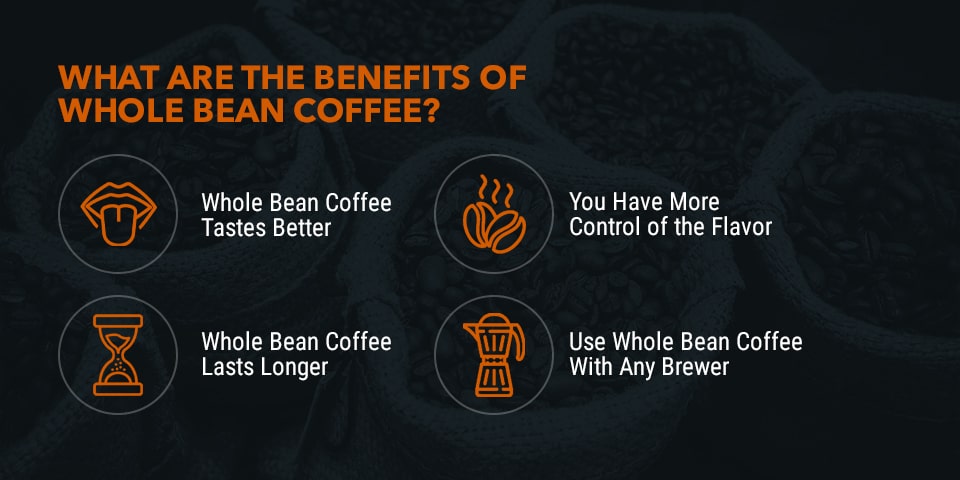
Whole Bean Coffee Tastes Better
Whole bean coffee’s primary benefit is its superior taste. Coffee purists appreciate the better brew quality they can achieve by using freshly ground beans. Whole bean coffee achieves this by waiting until the last minute to go through the oxidation process, preserving the layers of complex flavors coffee contains.
Drinking coffee you’ve recently ground yourself provides a more enjoyable experience than drinking prepackaged ground coffee because grinding the beans volatilizes their aromatic molecules. Breaking these molecules apart increases the coffee beans’ exposed surface area, resulting in faster oxidation. As soon as coffee beans begin to oxidize, they begin to lose their flavor.
Because the oxidation process happens so quickly after coffee comes in contact with air, grinding coffee beans decreases the coffee’s strength. The more time that passes between the grinding and brewing process, the weaker the coffee’s flavor gets. For this reason, many coffee connoisseurs prefer to only buy whole bean coffee and grind it themselves immediately before making their morning brew.
You Have More Control of the Flavor
By grinding whole bean coffee, you can also manipulate its flavors, because changing coffee beans’ grind size directly affects the brew. Purchasing whole bean coffee to grind at home lets customers tweak their coffee to their preferred tastes.
More specifically, coffee beans dissolve into the water at varying rates, which is a process known as extraction. First, extraction brings out the coffee beans’ acidity, then sweetness, then bitterness. The goal is to hit the sweet spot by using a coffee grind size that won’t extract too quickly or slowly, creating a balanced cup.
Whole Bean Coffee Lasts Longer
Contrary to popular belief, coffee beans are not a dried good you can keep in your pantry forever like a regular bean. Coffee beans are the seed of the coffee fruit, and, like all fruit, they have a shelf life. Because coffee is perishable, it is vital to handle it with care. Keeping coffee in its whole bean form instead of preground preserves its freshness for longer by protecting it from the air and oxidation.
Use Whole Bean Coffee With Any Brewer
With whole bean coffee, you are free to use any brewer you like, though you’ll have to match the grind size to your chosen brewing method. Some brewing methods, such as an auto espresso machine or a percolator, even require whole bean coffee because they need a specific grind size.
What Are the Drawbacks of Whole Bean Coffee?
While whole bean coffee comes with its fair share of benefits, it also has some drawbacks. Below are the cons of using whole bean coffee.
Whole Bean Coffee Takes Longer to Make
For many people, the most significant downside to using whole bean coffee is the extra time it takes to make in the morning. Grinding whole coffee beans before even beginning the brewing process is far less convenient than scooping preground coffee beans into a machine. For those who are new to grinding coffee, it may take extra time to figure out the ideal coarseness for their coffee grounds.
Whole Bean Coffee Requires More Equipment
Purchasing whole bean coffee makes owning a coffee grinder a necessity. However, true coffee lovers should choose a high-quality burr grinder. Using a low-quality blade grinder will result in inconsistent grind sizes, meaning some grinds will be too fine and some will be too large. Tiny fragments will produce a bitter brew, whereas larger chunks of beans will give the brew a sour taste.
Using a top-quality grinder that consistently grinds whole bean coffee to perfection is the secret to avoiding these taste discrepancies. Many coffee drinkers agree that preground coffee tastes better than whole bean coffee ground with a cheap blade grinder. For whole bean coffee to be worth it, a reliable burr grinder is a must.
Whole Bean Coffee Requires More Experimenting With Grind Sizes
Using whole bean coffee can come with a bit of a learning curve. Each person needs to play around with grind size to figure out what they think creates the best-tasting brew. Nailing the right amount of extraction in each brew may require a lot of time experimenting with grind sizes and techniques. In this way, using whole bean coffee instead of ground coffee requires a higher level of dedication and patience.
Whole Bean Coffee Takes Longer to Clean Up
Needing more equipment to make your coffee means there’s more to clean up afterward. Grinding whole bean coffee requires consumers to clean their grinder after each use, which takes some extra time and effort. You may also need to wipe down your countertops more frequently to ensure they’re clear of any stray coffee grounds.
What Are the Benefits of Ground Coffee?
Now that you’re a whole bean coffee expert, it’s time to go over the pros and cons of your coffee brand offering ground coffee to customers. Consider the benefits of preground coffee below.
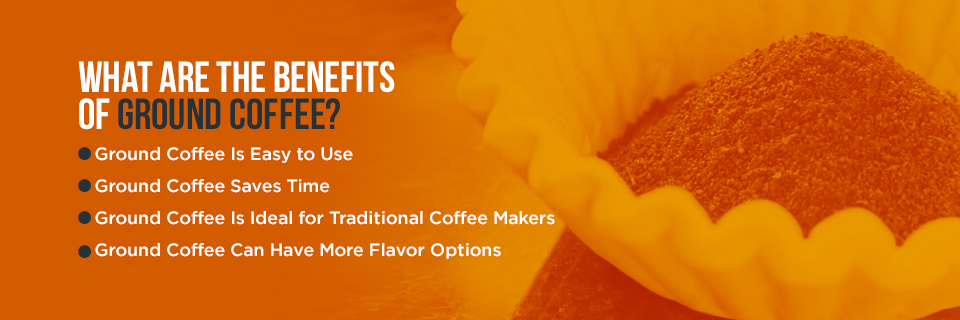
Ground Coffee Is Easy to Use
Ground coffee is so straightforward that it can save routine coffee drinkers a significant amount of time and mental energy. Using preground coffee eliminates the extra step of grinding the coffee yourself and significantly lowers the risk of brewing a bitter or sour pot of coffee due to inconsistent grinding.
Instead of carefully calculating the grinding process, all you have to do is scoop the coffee grounds into the filter, load the bundle into the coffee machine, and let the machine work its magic. This simple process makes ground coffee more appealing to any first-time or beginner coffee sippers.
Ground Coffee Saves Time
Convenience is ground coffee’s most notable advantage. When comparing scooping some ground coffee vs. whole bean measurement, grinding, and brewing, it’s no contest which method is the fastest. Only having to pour some coffee grounds into a filter and pressing the brew button is a considerable plus, especially for those who are always rushing to get out the door on time. They’ll also save the time they would’ve had to spend cleaning up after using a coffee grinder.
Ground Coffee Is Ideal for Traditional Coffee Makers
Most coffee consumers have a traditional drip coffeepot at home, which is perfect for using preground coffee. Ground coffee has an ideal coarseness for these machines, resulting in the perfect extraction method with each brew. Preground coffee’s consistency ensures the grounds will not be too coarse or fine for the traditional coffee maker’s brewing process.
Remember that ground coffee is compatible with any drip brewer, including a manual pour-over, so selling ground coffee doesn’t limit your target market solely to those with a traditional coffee maker.
Ground Coffee Can Have More Flavor Options
A notable benefit of ground coffee is the number of flavor options found on store shelves. Because whole bean coffee is less popular than ground coffee, many coffee companies tend to offer more varieties of ground coffee. The high demand for ground coffee allows coffee brands to experiment with more exciting roasts and roll out more exciting flavors for customers to experience.
What Are the Drawbacks of Ground Coffee?
While ground coffee offers plenty of benefits, this convenient form of coffee has its drawbacks, too. Keep reading to find out the potential negatives you need to take into account before selling preground coffee.
Ground Coffee Has Less Flavor and Freshness
Grinding whole coffee beans starts the oxidation process, and once this has begun, there’s no way to stop it. Though packaging methods are designed to considerably slow the degradation process, ground coffee still inevitably loses some of its flavor and freshness in time. If you sell ground coffee, make sure the packaging is flushed with an inert gas, such as nitrogen, to remove oxygen and keep the preground coffee in its peak form.
Ground Coffee Is More Likely to Be Stale
Grinding coffee increases the coffee’s overall surface area, leaving it more susceptible to environmental exposure. Elements such as moisture, heat, and humidity can cause ground coffee to go stale quicker than whole bean coffee. Specifically, grinding coffee opens it up to oxygen, which starts the degassing process.
Degassing refers to when coffee releases all the built-up gases from the beans during the roasting process. Grinding the beans leaves the coffee grounds open to the air, allowing for more of the coffee’s gases, flavors, and aromas to escape. Once ground coffee loses all its gases, it results in a flat, stale-tasting brew.
Ground Coffee Doesn’t Allow for Customizations
Unlike whole bean coffee, ground coffee does not allow consumers to customize the size of their grounds. While some people appreciate the consistent flavor preground coffee produces, others are frustrated by the lack of variety that ground coffee provides. Those who use ground coffee must stick with a specific brewing method with no adjustments to their brew.
Ground Coffee Is Incompatible With Some Brewers
Ground coffee is compatible with standard drip coffee pots. Because your coffee’s grind size must match your style of coffee brewer, preground coffee takes away the option of customizing your coffee for different styles. Though most people own a traditional drip coffee maker, only selling ground coffee could alienate coffee drinkers who like to use a French press, espresso maker, or any other type of brewing method.
Who Should Choose Whole Bean Coffee?
Whole bean coffee is an appealing product to coffee aficionados who want to experience the full flavors of their favorite beverage at their freshest and don’t mind putting in a little more time and effort to get that. Some people also prefer whole bean coffee because they enjoy experimenting with different grinding and brewing methods to get the perfect cup of coffee.
If your brand tends to cater to coffee connoisseurs, you’ll most likely be more successful in selling bags of whole bean coffee. Selling whole bean coffee can also make it easier to market your brand as artisan or upscale. You might even attract some less serious coffee lovers who don’t find the grinding process all that time-intensive and want to experiment with using whole bean coffee.
Who Should Choose Ground Coffee?
Ground coffee is the fastest way to get a cup of joe in your hands in the morning, making it an appealing choice for consumers who don’t take their coffee all that seriously and only want some convenient caffeine. Preground is also the obvious pick for anyone new to the coffee scene who doesn’t own a grinder or any of the fancy automatic machines that would require whole bean coffee.
Selling ground coffee can help your brand appeal to a broader audience instead of just coffee experts. If you want to focus even further on your customers’ convenience, consider packaging your ground coffee into single serve cups for Keurig or pods for Nespresso.
Bonus — How to Grind Whole Bean Coffee for the Right Flavor
As mentioned above, using whole bean coffee allows consumers to control their beverage’s precise flavors. The flavor whole bean coffee produces depends on the method used to grind it because the coffee grounds’ size determines the level of flavor extraction. Different-sized coffee grounds dissolve at varying rates, resulting in an array of possible tastes and textures.
More specifically, here is how consumers can manipulate the flavor of their whole bean coffee.
- Bitterness: Bitter flavors mean there was too much extraction from the coffee grounds, indicating over-brewing. Grinding the beans on a coarser setting reduces the overall extraction, giving the coffee a more balanced flavor.
- Sourness: On the other hand, sour coffee means there wasn’t enough extraction, indicating under-brewing. Using a finer grind size decreases the brewing speed, increasing the flavor extraction, to restore balance to the coffee’s overall taste.
- Brewing speed: Changing coffee beans’ grind size determines the speed at which they brew. Small coffee grounds extract quickly, while larger grounds take longer to brew.
To achieve the perfect cup of coffee, at-home coffee bean grinders should use a burr grinder instead of a blade grinder. A burr grinder can produce a more consistent grind than a single-blade grinder, thanks to its dual-disc system. Then, they will want to match the coarseness of their coffee grounds to their method of coffee brewing.
Use this guide to pair your coffee grounds’ size with your brewing method.
- French press: Extra coarse
- Percolators: Extra coarse
- Cold-brew coffee: Coarse
- Cafe solo brew: Medium coarse
- Traditional drip coffee: Medium
- Aeropress: Medium fine
- Espresso maker: Fine
- Moka pot: Fine
- Turkish coffee: Extra fine
Whether You Choose Whole Bean or Ground Coffee, Joe’s Garage Coffee Has You Covered
Regardless of whether you decide whole bean or ground coffee is better for your brand, Joe’s Garage Coffee has what you need to make your coffee company a success. We offer a wide product range, including whole bean coffee, ground coffee, and single serve coffee pods. We’ll help you determine the best packaging method for your brand and ensure you provide your customers with a top-quality product.
To find out how Joe’s Garage Coffee can assist your coffee brand’s growth, contact us today.
Related Content





